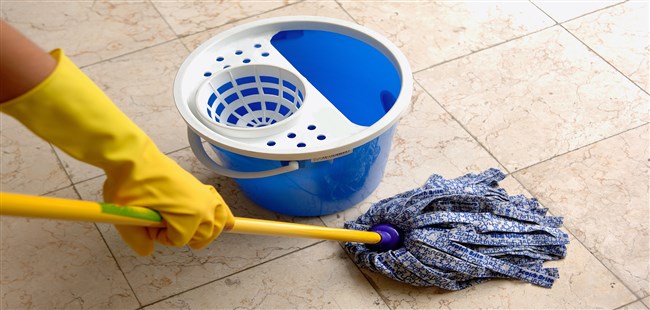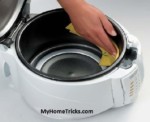Floors: Dirt is transmitted to floors from outdoors, so lay a doormat inside all exterior doors to remove dirt from shoes. If you keep floors clean by sweeping or vacuuming regularly, you will cut down on heavy-duty cleaning.
Cleaning Hard Floors
Hard floors that are dusty look dirtier than unvacuumed carpets. Sweep, vacuum, or mop them regularly – particularly hallway, kitchen, and bathroom floors. Wooden floors need polishing; marble, vinyl, and tile floors require heavy-duty cleaning from time to time.
Sweeping Floors
Removing dust: Sweep or vacum hard floors every few days, paying special attention to corners, where dirt collects and builds up.
Mopping Floors
Effective mopping: Damp mop all sealed floors weekly, using the two-bucket method. Do not use soap when mopping slate or stone floors.
Scrubbing Floors
Heavy-duty washing: Scrub stone, concrete, and tile floors with floor cleaner and a scrub brush occasionally to get rid of accumulated dirt.
Polishing Floors
Give floors a good shine, and your home will look well cared for. Use the right type of polish for your floor, and remember that polish builds up and will need to be removed from time to time. Use floor cleaner, ammonia, or commercial wax remover to remove polish.
Solid Paste Polishes
These solvent-based polishes are suitable for vinyl, wood, and cork. The application is difficult and must be done by hand, but the shine lasts a long time.
Liquid Solvent Polishes: These are also suitable for vinyl, wood, and cork. They are easier to use than solid paste polish, but they are not as long-lasting.
Water-Based Emulsion Polishes
These usually contain silicone. They can be used on all floors except linoleum, unsealed wood, and cork. They are easy to apply and long-lasting.
Improvising a polisher: Tie a dust cloth around a soft broom, and use this instead of an electric polisher to apply and buff wax polish. Always clean floors thoroughly before you apply polish for the first time.
Types Of Floors
Some floors take a lot of heavy wear, and different types of surface need varying amounts of attention. Sweep hard floors daily if necessary, and clean them according to their type. Do not let dirt build up so that cleaning a floor becomes a hands-and-knees job.
Type Treatment
Vinyl:An easy-care flor that lasts well for correctly. Sweep regularly. When dirty, wash vinyl with a solution of household detergent and warm water. Rinse with clear water. Twice a year remove the vinyl gloss coaling with a proprietary stripper. When dry, coat the vinyl with the manufacturer’s recommended floor dressing.
Remove stubborn marks with emulsion polish.
Linoleum; A tough flooring, but take care not to overwet, because this tile can cause damage.
Wipe linoleum floors with a mop dampened in a weak solution of water and household detergent. Use a water-based polish – which will not leave a watermark – on kitchen and bathroom floors, and a wax polish on floors elsewhere in the home.
Remove scuff marks by Ribbing with fine-grade steel wool dipped in turpentine.
Wood treatment depends on whether or sweep, or dry mop unsealed floors regularly to remove dust and dirt. Clean sealed wooden floors with a mop dampened and wrung out. To give the floor a shine, polish with wax or emulsion polish.
Use a damp cloth to remove sticky marks on unsealed floors. Remove wax polish from sealed wooden floors with a cloth and turpentine.
Cork:Needs regular sweeping. Make sure you do mopping, or it will crack. Mop regularly with a solution of warm water and household detergent, and apply wax polish occasionally. Try to avoid a buildup of polish around the edges of the room as this eventually results in a sticky deposit that attracts dirt.
When laying cork tiles, ensure that the edges are sealed to stop water seeping in from the sides.
Be careful: Clean with a solution of dishwashing liquid applied with a sponge mop or a cloth, then wipe over with a chamois leather. Mop up spills immediately wet floors are dangerously slippery. Do not polish ceramic tiles, since this will make them slippery. Clean grouting with a soft-bristled brush dipped in a strong solution of detergent.
Quarry Tiles Pretty: But porous unless turpentine, then apply paste Glazed quarry tiles need mopping regularly with water and a little general-purpose cleaner. Scrub unglazed quarry tiles with this solution to remove dirt. Rinse thoroughly. Polish with liquid or solid paste polish, preferably nonskid. Treat newly laid tiles with linseed oil. Do not wash them for at least two weeks afterward.






